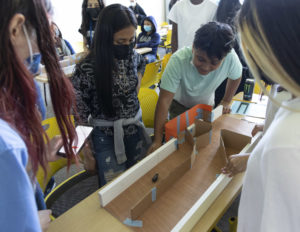 The Watershed Institute has increased its engagement with Trenton schools, empowering students to create deeper connections with their waterways, understand the impact of human activities on the environment, and explore possible careers in environmental science.
The Watershed Institute has increased its engagement with Trenton schools, empowering students to create deeper connections with their waterways, understand the impact of human activities on the environment, and explore possible careers in environmental science.
About 160 students from Rivera Community and Grace A. Dunn middle schools visited the Watershed Center this spring to learn about spawning American Shad, which migrate past the City of Trenton each year. They worked in groups to create a way for migrating fish to navigate around a dam to lay eggs in their native rivers using a hands-on STEM (science, technology, engineering and math) module.
“This was most of these students first time ever engaging in the engineering design process. They had to plan, budget, build, test, and redesign,” said Watershed Educator Stephanie Silva. “There were several groups who were able to successfully get their Hexbugs, which represented the shad, to the other side of the dam in just three seconds!”.
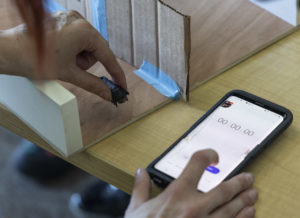 Another 160 students from Trenton Central High School and Trenton Ninth Grade Academy participated in a hybrid program in early and mid-May. In the first part, they watched a video in their classrooms of Watershed staff demonstrating water quality monitoring at Assunpink Creek at Mill Hill Park in Trenton. Watershed staff shared how they assess the negative impact of polluted stormwater runoff from city streets, animal waste, oils, chemicals, and other contaminants that harm biodiversity and local waterways.
Another 160 students from Trenton Central High School and Trenton Ninth Grade Academy participated in a hybrid program in early and mid-May. In the first part, they watched a video in their classrooms of Watershed staff demonstrating water quality monitoring at Assunpink Creek at Mill Hill Park in Trenton. Watershed staff shared how they assess the negative impact of polluted stormwater runoff from city streets, animal waste, oils, chemicals, and other contaminants that harm biodiversity and local waterways.
The video prepared the students to do their own water quality monitoring in the Stony Brook during a subsequent field trip to The Watershed Institute’s headquarters near Pennington. Next, they toured rain gardens and other green infrastructure and learned how these landscape features slow down and absorb harmful nutrients in a way that mimics nature. Green infrastructure allow native plants to gradually release the cleansed stormwater back into the ground and aquifer.
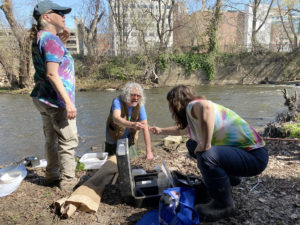 “The goal was for them to compare the different landscapes and how human activities can impact waterways,” Stephanie continued. “When they came to The Watershed Institute, they visited the Stony Brook and did the same water quality analysis.”
“The goal was for them to compare the different landscapes and how human activities can impact waterways,” Stephanie continued. “When they came to The Watershed Institute, they visited the Stony Brook and did the same water quality analysis.”
The students and teachers were introduced by Watershed staff to the Model My Watershed program, a platform that simulates runoff, infiltration and evapotranspiration using actual land-use data. Students could simulate changes to the land by adding rain gardens, bioswales, green roofs, porous pavement, and forests to see the effect on the quantity and quality of runoff.
All four field trips generated excitement, curiosity and a buzz among the students, teachers, and staff.
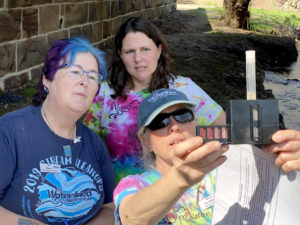 Lindsay Steirer Taylor, who teaches biology at TCHS, said the Watershed outing hit home.
Lindsay Steirer Taylor, who teaches biology at TCHS, said the Watershed outing hit home.
“It was incredibly obvious that they had not only heard the information about our water supplies but processed that information and started considering ways to improve the situation here in Trenton,” she said.
Jim Waltman, Executive Director of the Watershed, said these outings offer Trenton students a way to understand and devise solutions to deal with the intense, powerful storms and flooding brought about by climate change.
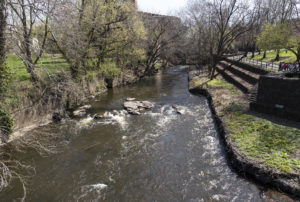 “These students expanded their knowledge of why flooding occurs more often and learned about ways they can create solutions to these problems,” Waltman said. “We want to empower students from Trenton and throughout our region with hands-on learning that helps them figure out strategies to reduce the impact of human activities on our waterways and the environment.”
“These students expanded their knowledge of why flooding occurs more often and learned about ways they can create solutions to these problems,” Waltman said. “We want to empower students from Trenton and throughout our region with hands-on learning that helps them figure out strategies to reduce the impact of human activities on our waterways and the environment.”

